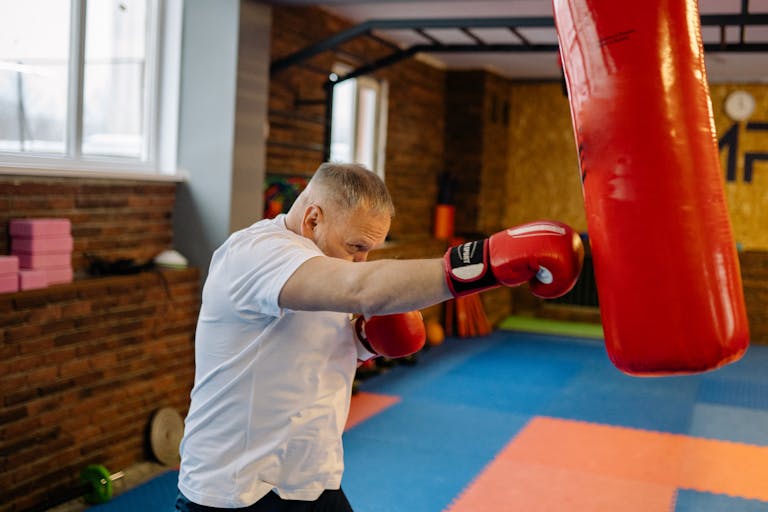FREE SHIPPING OVER $50
He Couldn’t Climb Stairs at 60—6 Months of Bedroom Exercises Left Doctors Speechless

The ability to climb a simple flight of stairs is often taken for granted until you can no longer do it. For many individuals after 60, functional strength—the power needed for everyday tasks—begins to decline rapidly. This was the reality for a family friend of mine, who, despite being generally healthy, found himself completely winded and unable to manage a single flight of stairs without intense knee pain and instability. The culprit wasn’t necessarily a sudden illness; it was the slow, insidious process of sarcopenia, or age-related muscle loss.
He knew a big, intimidating gym routine wasn’t for him. He needed something simple, low-impact, and doable every single day, right in the privacy of his home. Inspired by a physical therapist’s advice to focus on unilateral (single-leg) strength and hip mobility, he developed a short, quiet routine using only his bedroom floor and a sturdy chair. Six months later, the results were astounding: his mobility was restored, the knee pain was gone, and his physician, reviewing his bone density and muscle mass scans, was left truly speechless. This is the exact routine that rebuilt his lower body strength and gave him back his independence.
The Root Cause: Why Stairs Become Impossible After 60
The reason climbing stairs becomes such a struggle is multifaceted, but it primarily boils down to a failure in two key areas that this routine directly addresses.
1. Loss of Explosive Power
Climbing stairs is a single-leg activity requiring a burst of concentric (shortening) muscle action from the glutes and quadriceps. As we age, we lose fast-twitch muscle fibers—the fibers responsible for quick, powerful movements. This is why even a small step feels like a huge effort.
2. Failure in Hip and Knee Stability
Functional movements like stair climbing demand stable hips and knees. Without strong gluteus medius muscles (the side glutes) and strong hamstrings, the knee joint becomes unstable and often collapses inward, leading to the debilitating knee pain that forces people to stop. The bedroom routine focuses heavily on isolating and strengthening these specific stabilizing muscles.
The 6-Month Bedroom Routine: 4 Exercises for Functional Strength
The key to this routine’s success was its absolute simplicity and the fact that it was performed first thing every morning before getting dressed. He focused on 3 sets of 10 repetitions for each exercise.
1. The Single-Leg Glute Bridge (Targeting Glute Max and Core)
This exercise rebuilds the foundational power in the glutes and hamstrings while forcing the core to stabilize the pelvis. This is a perfect move to do right in bed or on a floor mat.
- How to do it: Lie on your back with knees bent and feet flat on the floor. Lift one leg straight up. Drive your heel into the floor and push your hips upward until your body forms a straight line from shoulder to knee. Hold briefly, squeezing the glute of the working leg.
- Why it works: It forces the glute on the working side to perform 100% of the effort, creating the single-leg strength necessary for pushing off a step. This quickly targets the powerful, essential fast-twitch fibers.
2. The Lateral Leg Raise (Targeting Glute Medius Stability)
As discussed, poor hip stability is a major cause of knee pain and imbalance. This move isolates the gluteus medius (the side glute), which is the primary stabilizer for standing on one leg—exactly what you do when climbing stairs.
- How to do it: Lie on your side, maintaining a straight line from head to feet. Slowly lift your top leg straight up toward the ceiling, keeping your foot pointed forward (do not let your toes rotate upward). Lower slowly and with control.
- Why it works: Strengthening the Glute Med stabilizes the hip joint, which keeps the knee tracking correctly over the foot, eliminating the stress and instability that causes knee pain when walking or climbing.
3. The Supported Single-Leg Squat (Mastering the Stair-Climbing Motion)
This exercise is the gold standard for replicating the precise motion and balance required for climbing stairs, but with safety and control.
- How to do it: Stand directly in front of a sturdy chair or the edge of your bed. Lift one foot slightly off the ground. Slowly lower yourself, controlling the movement down until you lightly tap the chair’s edge (or just stop before sitting). Drive back up powerfully, keeping your knee aligned over your foot. Use a wall or door frame for light support if needed.
- Why it works: It builds the crucial eccentric strength (the lowering phase, which prevents knee damage) and the explosive concentric strength needed to push up the next step, directly simulating the stair-climbing action.
4. Standing Calf Raises (Powering the Final Push)
The final push when climbing stairs comes from the calf muscles (gastrocnemius and soleus). Rebuilding this power is vital for stability and a strong finish.
- How to do it: Stand facing a wall or the back of a chair for balance. Rise slowly onto the balls of your feet, lifting your heels as high as possible. Hold briefly at the top and lower down with control. For an added challenge (after several weeks), try this one leg at a time.
- Why it works: Strong calf muscles improve ankle mobility and foot stability, which translates directly to a more powerful and safer push-off, giving you the confidence to trust your steps.
The Speechless Factor: What Shocked the Doctors
The family friend wasn’t just working out; he was engaging in a targeted physical therapy regimen that reversed years of muscle atrophy. After 6 months, his doctors were speechless when they saw the measurable clinical improvements.
1. Measurable Muscle Gains
His DEXA scan (often used to measure bone density) revealed a significant increase in muscle mass in his lower body. This defied the typical trend of muscle loss after 60 and proved that the resistance training was successful at rebuilding metabolically active tissue. More muscle also meant a higher resting metabolism.
2. Improved Bone Density
The low-impact, controlled weight-bearing exercise was exactly what his bones needed. Resistance training is one of the most effective ways to signal the body to build and retain bone density, reducing the risk of fracture and improving long-term longevity.
3. Eliminated Pain and Increased Functional Mobility
Clinically, the most important outcome was the elimination of his persistent knee pain and the restoration of his functional mobility. He could not only climb stairs but also carry groceries and walk for longer distances without fatigue or discomfort. His newfound strength was practical, not just aesthetic.
Sustaining the Strength: Making the Routine Stick
The success wasn’t in the intensity; it was in the consistency. Here is how he made the 6-month routine a permanent part of his health strategy.
- Habit Stacking: He performed the exercises immediately after drinking his first glass of water every morning. He used a simple, repeatable trigger to ensure compliance.
- Focus on Form, Not Weight: Because he used bodyweight and low-impact moves, the risk of injury was minimal. His focus remained on slow, controlled form to maximize the muscle activation and neurological retraining.
- Progression: After the first few months, he progressed the Single-Leg Squat by holding small household items (like heavy books or full water bottles) to safely increase the resistance.
Final Thoughts
The painful truth is that ignoring the need for strength training after 60 can quickly lead to a loss of independence, symbolized by the inability to climb stairs. However, this story proves that targeted, consistent, low-impact bedroom exercises focused on building single-leg strength and hip stability can dramatically reverse age-related decline. By committing to this simple routine, he not only silenced his knee pain and conquered the stairs but achieved a level of functional fitness that truly left his doctors speechless, providing an inspiring blueprint for anyone looking to reclaim their mobility and longevity.
Related Articles
- Do These 10 Exercises Regularly—They’re Proven to Help You Live Longer
- Sick of Chronic Migraines? These 6 Yoga Moves + Breathwork Could Be Your Natural Relief
- Want to Look and Feel 17 Years Younger? These 15 Anti-Aging Hacks Are Backed by Science
- The Anti-Aging Habit Hidden in a Remote Village—Doctors Say It Rewinds Your Biological Clock
- Fitness Over 45? These 5 ‘Healthy’ Habits Are Secretly Sabotaging Your Muscle Gains



